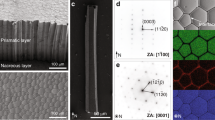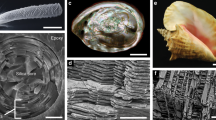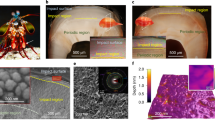Abstract
Natural composite materials are renowned for their mechanical strength and toughness: despite being highly mineralized, with the organic component constituting not more than a few per cent of the composite material, the fracture toughness exceeds that of single crystals of the pure mineral by two to three orders of magnitude1. The judicious placement of the organic matrix, relative to the mineral phase, and the hierarchical structural architecture extending over several distinct length scales both play crucial roles in the mechanical response of natural composites to external loads2,3,4. Here we use transmission electron microscopy studies and beam bending experiments to show that the resistance of the shell of the conch Strombus gigas to catastrophic fracture can be understood quantitatively by invoking two energy-dissipating mechanisms: multiple microcracking in the outer layers at low mechanical loads, and crack bridging in the shell's tougher middle layers at higher loads. Both mechanisms are intimately associated with the so-called crossed lamellar microarchitecture of the shell, which provides for ‘channel’ cracking in the outer layers and uncracked structural features that bridge crack surfaces, thereby significantly increasing the work of fracture, and hence the toughness, of the material. Despite a high mineral content of about 99% (by volume) of aragonite, the shell of Strombus gigas can thus be considered a ‘ceramic plywood’, and can guide the biomimetic design of tough, lightweight structures.
This is a preview of subscription content, access via your institution
Access options
Subscribe to this journal
Receive 51 print issues and online access
$199.00 per year
only $3.90 per issue
Buy this article
- Purchase on Springer Link
- Instant access to full article PDF
Prices may be subject to local taxes which are calculated during checkout




Similar content being viewed by others
References
Wegst, U. G. K. & Ashby, M. F. Material selection charts for natural materials. Report No. CUED/C_EDC/TR55 (Cambridge Univ., 1997).
Taylor, J. D. & Layman, M. The mechanical properties of bivalve (mollusca) shell structures. Palaeontology 15, 73–86 (1972).
Currey, J. D. & Taylor, J. D. The mechanical behaviour of some molluscan hard tissue. J. Zool. Lond. 173, 395–406 (1974).
Currey, J. D. in Mechanical Properties of Biological Materials (eds Currey, J. D. & Vincent, J. F. V.) 75–97 (Cambridge Univ. Press, 1980).
Bøggild, O. B. The shell structure of the mollusks. K. Danske Vidensk. Selsk. Skr. 2, 232–325 ( 1930).
Carter, J. G. in Skeletal Growth of Aquatic Organisms (eds Rhoads, D. C. & Lutz, R. A.) 69–113 (Plenum, New York, 1980).
Curry, J. D. & Kohn, A. J. Fracture in the crossed-lamellar structure of Conus shells. J. Mater. Sci. 11 , 1615–1623 (1976).
Jackson, A. P., Vincent, J. F. V. & Turner, R. M. The mechanical design of nacre. Proc. R. Soc. Lond. B 234, 415–440 (1988).
Jackson, A. P., Vincent, J. F. V. & Turner, R. M. Comparison of nacre with other ceramic composites. J. Mater. Sci. 25, 3173– 3178 (1990).
Kuhn-Spearing, L. T., Kessler, H., Spearing, S. M., Ballarini, R. & Heuer, A. H. Fracture mechanisms of the Strombus gigas conch shell: Implication for the design of brittle laminates. J. Mater. Sci. 31, 6583– 6594 (1996)
Kessler, H., Ballarini, R., Mullen, R. L., Kuhn, L. T. & Heuer, A. H. A biomimetic example of brittle toughening: (I) steady state multiple cracking. Comput. Mater. Sci. 5, 157–166 ( 1996).
Cox, B. & Marshall, D. B. Concepts for bridged cracks in fracture and fatigue. Overview No. 111. Acta Metall. Mater. 42, 341–363 ( 1994).
Acknowledgements
A.H.H. and R.B. thank V. Laria, H. Kessler and L. Kuhn, former postdoctoral research fellows, for their contributions to his understanding of the shell of Strombus gigas. This research was supported by EPRI.
Author information
Authors and Affiliations
Corresponding author
Rights and permissions
About this article
Cite this article
Kamat, S., Su, X., Ballarini, R. et al. Structural basis for the fracture toughness of the shell of the conch Strombus gigas. Nature 405, 1036–1040 (2000). https://doi.org/10.1038/35016535
Received:
Accepted:
Issue Date:
DOI: https://doi.org/10.1038/35016535
This article is cited by
-
Fabrication and Testing of Bioinspired Composites with Curved Multilayer Microstructures
JOM (2023)
-
Polycrystalline morphology and mechanical strength of nanotube fibers
npj Computational Materials (2022)
-
Micromechanics of composites with interface effects
Acta Mechanica Sinica (2022)
-
A mechanical model of the crack-bridging effect in nacre with interlocking interface
Archive of Applied Mechanics (2022)
-
Degradation of ancient Maya carved tuff stone at Copan and its bacterial bioconservation
npj Materials Degradation (2021)
Comments
By submitting a comment you agree to abide by our Terms and Community Guidelines. If you find something abusive or that does not comply with our terms or guidelines please flag it as inappropriate.



